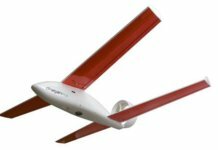The U.S. Department of Transportation (DOT) has proposed new rules for flying unmanned aircraft systems (UAS) at night and over people, announced its intention to seek public input on drone safety and security issues, and awarded contracts for a UAS traffic management pilot project.
Elaine L. Chao, DOT secretary, announced the new initiatives on Monday during the Transportation Research Board Annual Meeting in Washington, D.C. Currently, remote pilots are permitted to fly drones over people or at night through Part 107 waivers from the Federal Aviation Administration (FAA).
“We are not in the business of picking technology winners and losers. Our philosophy is to encourage the widest possible development of safe new transportation technologies so consumers and communities can choose the mix of options that suits them best,” she said.
“To implement this philosophy, today we’d like to share with you a sneak preview of three new department initiatives to encourage the safe testing and deployment of drones. This will help communities reap the considerable economic benefits of this growing industry and help our country remain a global technology leader.”
The draft notice of proposed rulemaking (NPRM) would amend Part 107 to enable “routine small UAS operations over people and at night,” the FAA’s NPRM says.
“This rule would require manufacturers ensure that small UAS they build for flying over people adhere to certain standards to mitigate the risk of injury to people should the aircraft fail. This rule would also set operational standards for all remote pilots in command who conduct operations over people and who conduct operations at night.”
To fly at night, remote pilots would need to use an anti-collision light that is visible for 3 statute miles and would also need to complete an “updated knowledge test or recurrent training as applicable to ensure familiarity with the risks and appropriate mitigations for nighttime operations.” The FAA has also proposed, however, that the anti-collision lighting requirement would be subject to waiver.
For flights over people, the FAA has proposed three categories based on the level of human injury risk. Category 1 is for small UAS weighing under 0.55 pounds, consisting “almost exclusively” of aerial photography applications, says the FAA. For these low-risk aircraft, the FAA has proposed to enable operations “without any additional manufacturer or operational restrictions beyond what Part 107 already requires and any other applicable laws and regulations.”
Category 2 would be based on more than just weight of the aircraft. Before the drone could be used to fly over people, the manufacturer would be required to demonstrate that it meets certain “injury threshold requirements.”
“Operators would be required to adhere to any other existing requirements in Part 107 that apply to operating small UAS generally, but the FAA does not propose any operational restrictions specific to operations over people for Category 2,” the draft rule says.
Finally, Category 3 allows for a higher injury threshold than does Category 2, but it “limits an individual’s exposure to the risk of injury through operational limitations.” For example, it would prohibit flights over “any open-air assembly of people”; the flights would have to be “within or over a closed- or restricted-access site and anyone within that site would have to be notified that a small unmanned aircraft may fly over them”; and for flights not within or over a closed- or restricted-access site, the drone “may transit but not hover over people.” In addition, like in Category 2, the manufacturer would need to demonstrate that the aircraft meets certain injury threshold requirements.
Separately, as laid out in a draft advance notice of proposed rulemaking (ANPRM), the FAA plans seek public input to identify major drone safety and security issues that may pose a threat to other aircraft, to people on the ground or to national security.
“Specifically, the FAA seeks comment on whether and in what circumstances the FAA should promulgate new rulemaking to require stand-off distances, additional operating and performance restrictions, the use of UAS Traffic Management (UTM), and additional payload restrictions,” the ANPRM states. The FAA is also seeking comments on “whether it should prescribe design requirements and require that unmanned aircraft be equipped with critical safety systems.”
Both the NPRM and ANPRM will be published in the Federal Register at a later date, says the DOT.
Lastly, the DOT announced its selections for the Unmanned Aircraft Systems Traffic Management System Pilot Project. The pilot project, through September, is designed to demonstrate a UAS traffic management system and create a shared information network to gather data that can be used for future rulemakings, the department explains. Following a “stringent application and evaluation process,” the DOT says, it has awarded contracts to the Nevada UAS Test Site Smart Silver State, the Northern Plains Unmanned Aircraft Systems Test Site and the Virginia Tech Mid-Atlantic Aviation Partnership.
In response to the department’s latest actions, Brian Wynne, president and CEO of the Association for Unmanned Vehicle Systems International (AUVSI), says in a statement, “These FAA rulemakings will help advance the commercial UAS industry beyond the current regulatory framework. Expanded operations such as operations over people are currently allowed through the FAA’s waiver process on a case-by-case basis, and CNN and State Farm are among the companies already conducting these flights safely. A rule that allows for widespread operations over people without requiring a waiver will allow more operators to harness the great potential of UAS.
“The FAA’s separate call for comments on a proposed rule concerning operational limitations, airspace restrictions, hardware requirements, and associated identification and tracking technologies will further shape a national UAS policy,” Wynne adds.








